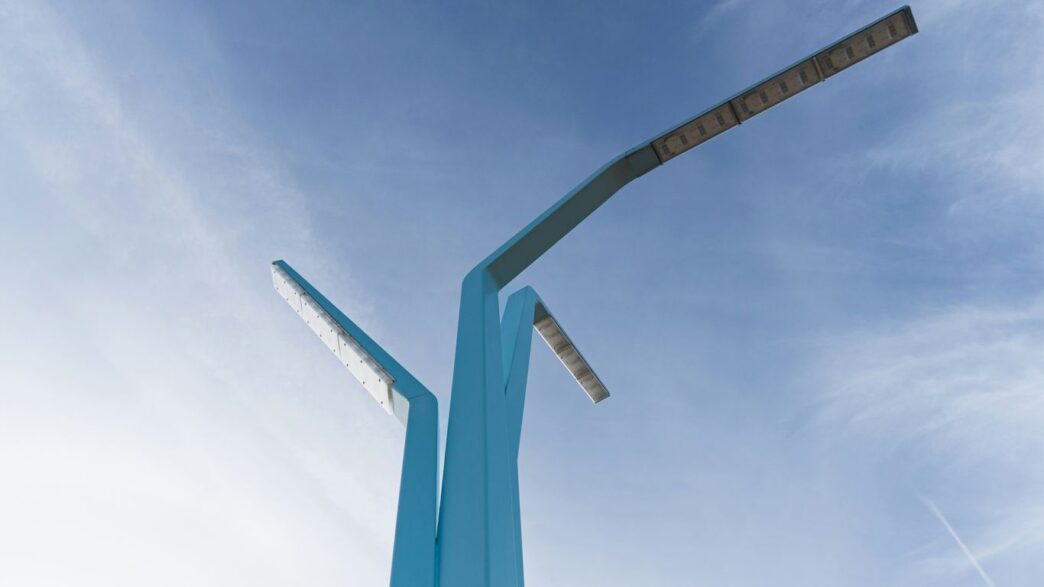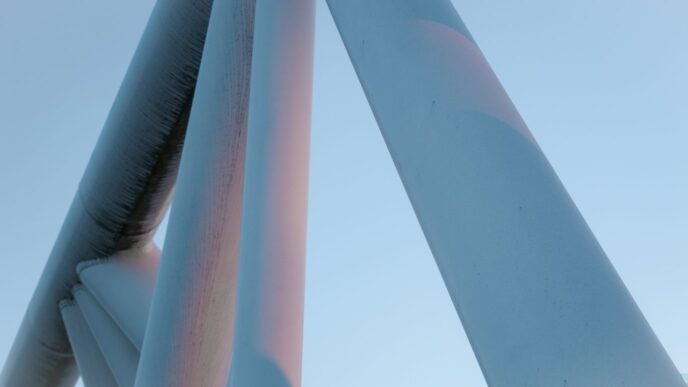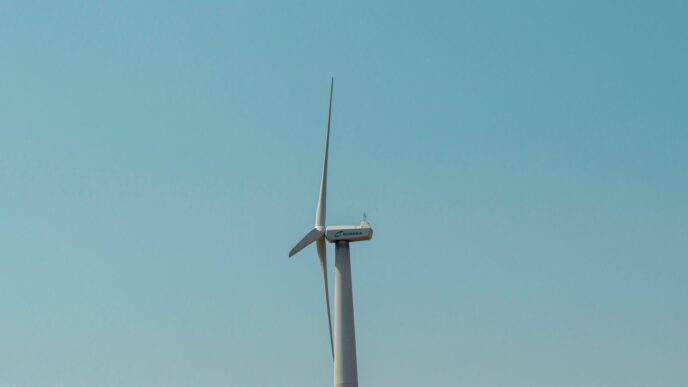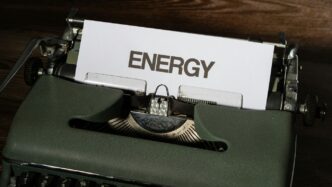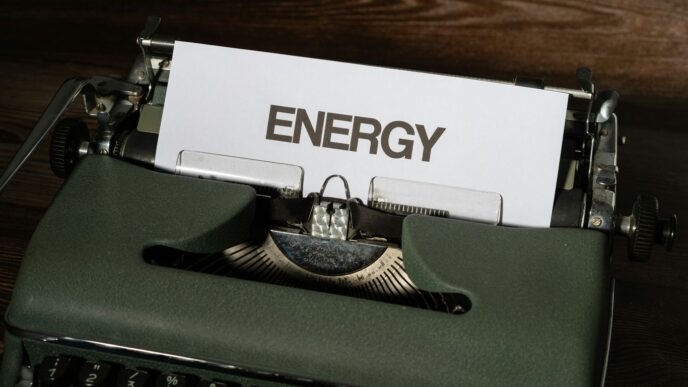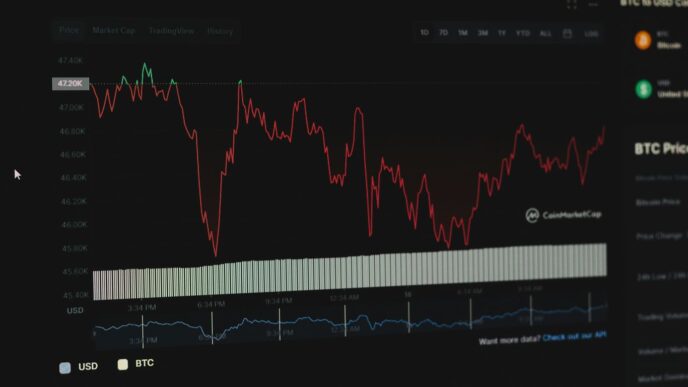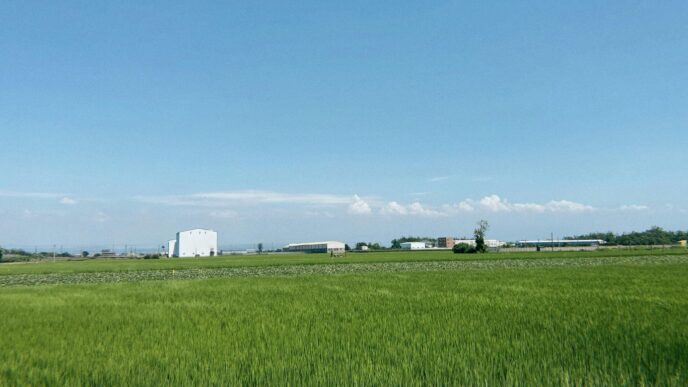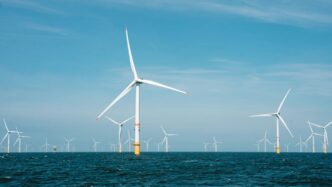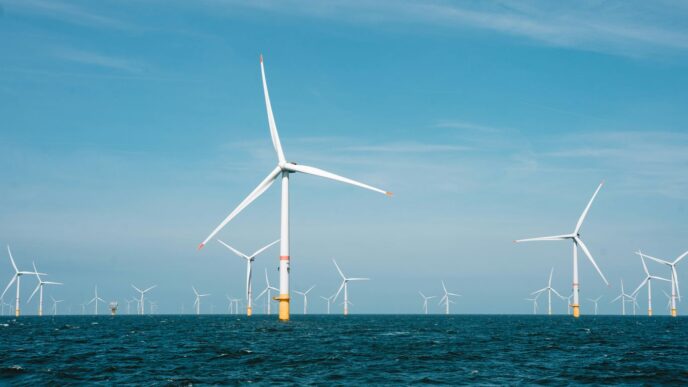Wind turbines have become a pretty common sight, haven’t they? You see them out in fields or along the coast, these giant structures spinning away. But have you ever stopped to think, just how big is a wind turbine blade? It’s not just a small detail; the size of these blades really matters for how much power they can generate. We’re talking about some seriously impressive dimensions that have grown a lot over the years as technology gets better. Let’s dive into what makes these blades so massive and why it’s important.
Key Takeaways
- Modern land-based wind turbine blades are often over 170 feet long, with rotor diameters that can be longer than a football field.
- Offshore turbines typically have even larger blades than onshore ones, allowing them to capture more wind energy from stronger, more consistent ocean winds.
- The length of a wind turbine blade directly impacts its wind-swept area; longer blades mean more wind captured and thus more power generated, with power output increasing exponentially with blade length.
- The GE Haliade-X is a notable example, featuring blades around 107 meters (351 feet) long, comparable to a football field, and capable of powering homes for days with a single rotation.
- While larger blades mean more energy, engineers face challenges with structural integrity, material science, transportation, and physical limitations, alongside environmental factors like disposal.
Understanding Wind Turbine Blade Dimensions
When you see those giant wind turbines dotting the landscape, or even out at sea, have you ever stopped to wonder just how big those blades actually are? It’s not just a random number; the size of these blades is a pretty big deal when it comes to how much power a turbine can generate. Think of it like a solar panel – the bigger it is, the more sunlight it can catch, right? Wind turbine blades work on a similar principle.
Typical Land Turbine Blade Sizes
For the turbines you typically see on land, the blades have gotten seriously long. We’re talking about blades that are often over 170 feet (that’s about 52 meters) long. To give you a picture, that’s longer than a standard American football field! The whole spinning part, called the rotor, usually ends up being about half the height of the tower itself. These towers themselves can be quite tall, often in the range of 200 to 260 feet (65 to 80 meters). The reason they go so high is simple: the wind blows stronger the higher you go, meaning more energy can be captured.
Offshore Turbine Blade Scale
Now, if you think land turbines are big, wait until you see the offshore ones. These giants are built to catch the even stronger and more consistent winds found out at sea. Their blades are frequently even longer than those on land. Some offshore turbines have rotor diameters that are more than half the height of their towers. This massive scale allows them to harness a huge amount of wind energy, making them incredibly efficient.
The Significance of Blade Length
So, why all the fuss about length? It really comes down to something called the ‘wind-swept area.’ This is basically the total area the blades cover as they spin. The longer the blades, the bigger this area is. A bigger area means the turbine can catch more wind. And here’s the cool part: the relationship between blade length and power isn’t just a little bit more power; it’s exponential. If you double the length of the blades, you can potentially quadruple the amount of power the turbine can generate. It’s a pretty wild jump!
Here’s a quick look at how blade length relates to power:
- Shorter Blades: Capture less wind, generate less power.
- Medium Blades: Capture a good amount of wind, suitable for many locations.
- Very Long Blades: Capture significantly more wind, leading to much higher power output, especially in optimal wind conditions.
Of course, it’s not just about the length. Things like how fast the wind is blowing and how dense the air is also play a part. Denser air, like you find in colder climates or at lower elevations, has more ‘stuff’ in it, which means more force on the blades. But that blade length? That’s the primary driver for how much wind energy a turbine can grab.
The Impact of Blade Size on Energy Production
So, we’ve talked about how big these blades are, but why does it even matter? Well, it turns out that the size of a wind turbine’s blades has a pretty big say in how much electricity it can actually make. It’s not just a little bit of a difference, either; it’s a pretty significant one.
Wind-Swept Area and Power Output
Think of the blades like a giant fan. The bigger the blades, the more air they can catch. This area that the blades sweep over is called the ‘wind-swept area.’ A larger wind-swept area means the turbine can grab more wind energy. It’s a pretty straightforward idea: more wind captured equals more power generated. The longer the blades, the more wind they can gather, and the more electricity you get out of it.
Influence of Wind Speed and Air Density
Now, it’s not just about the blades, though. Wind speed is a huge factor. Turbines need a certain amount of wind to even start spinning and making power, usually around 6 miles per hour. They hit their sweet spot for maximum power generation somewhere between 25 and 30 miles per hour. Too much wind, though, and they have to shut down to avoid damage, typically around 55 miles per hour. So, the size of the blades needs to be matched with the typical wind speeds of a location.
Air density plays a part too. Denser air, which you find in colder temperatures or at lower elevations, has more ‘stuff’ in it. This means it pushes harder on the blades, creating more lift and generating more power. So, a big turbine in a place with dense air can be a real powerhouse.
Exponential Relationship Between Size and Power
Here’s where it gets really interesting. The connection between blade size and the power a turbine can produce isn’t just a simple straight line. It’s actually exponential. What does that mean? Well, if you double the length of the blades, you don’t just double the power output. You actually get about four times the power! This is a big reason why manufacturers keep trying to make blades bigger and bigger – the payoff in energy production is huge.
Here’s a simplified look at how it works:
- Blade Length: The primary driver of the wind-swept area.
- Wind-Swept Area: Directly proportional to the square of the blade length.
- Power Output: Roughly proportional to the wind-swept area and the cube of the wind speed.
This means that even small increases in blade length can lead to substantial gains in electricity generation, making larger turbines a very attractive option for increasing renewable energy output.
Exploring the Largest Wind Turbine Blades
You know, when you see those massive wind turbines out in a field or out at sea, it really makes you stop and think. They’re just enormous. And the blades? They’re the real stars of the show, aren’t they? They’re getting bigger and bigger, and it’s pretty wild to think about.
The GE Haliade-X: A Record Holder
Right now, one of the biggest players in the game is GE’s Haliade-X. This thing is a beast, designed for offshore wind farms. When it first came out, it was setting records. We’re talking about a turbine with a capacity that can reach up to 14 megawatts. That’s a lot of power! The whole structure is huge, but let’s focus on those blades. Each one is about 107 meters long. To give you a sense of scale, that’s longer than a football field. Seriously, it’s longer than a Boeing 747 airplane is wide.
Comparing Blade Lengths to Familiar Objects
It’s hard to wrap your head around just how long these blades are. Let’s break it down:
- GE Haliade-X Blade: Roughly 107 meters (about 351 feet). This is longer than a standard American football field (including end zones).
- Boeing 747: The wingspan of a 747 is about 68 meters (224 feet). So, the Haliade-X blade is significantly longer.
- Statue of Liberty: The statue itself is about 46 meters (151 feet) tall. You could lay more than two of them end-to-end along one Haliade-X blade.
- Usain Bolt: If the fastest man on Earth ran from one end of the blade to the other, it would take him around 10 seconds. That’s how long it is!
Power Generation Capabilities of Giant Blades
So, why all the fuss about making them so big? It’s all about capturing more wind. The bigger the blade, the more wind it can catch, and the more electricity it can generate. A single rotation of the Haliade-X’s blades can reportedly power a home for two days. And over a year, one of these giant turbines can produce around 74 gigawatt-hours of electricity. That’s enough to power tens of thousands of homes. It’s pretty amazing to think that these spinning giants are helping to power our world.
Engineering Challenges in Blade Design
Building these giant wind turbine blades isn’t just about making things bigger; it’s a serious engineering puzzle. Think about it: these massive structures have to spin reliably for decades, through all sorts of weather. It’s a tough gig.
Structural Integrity and Extreme Weather
One of the biggest headaches for engineers is making sure these blades can handle whatever Mother Nature throws at them. We’re talking hurricane-force winds, ice buildup, and constant stress from spinning. The materials need to be incredibly strong yet flexible enough to avoid snapping. Imagine a blade that’s over 100 meters long – that’s longer than a football field! If it starts to bend too much, it could actually hit the tower. Engineers have to run countless simulations to predict how the blades will behave under extreme conditions and design them to withstand those forces without failing. It’s a constant balancing act between strength and weight.
Material Science and Transportation Logistics
So, what do you make these behemoths out of? It’s not just plastic. We’re talking advanced composites, often a mix of fiberglass and carbon fiber, carefully layered and bonded. These materials are strong and light, but they’re also expensive and tricky to work with on such a large scale. Then comes the transportation. Getting a blade that’s longer than a city block from the factory to the wind farm site is a logistical nightmare. Special trucks, road closures, and sometimes even barges are needed. It’s not like you can just pop it on the back of a pickup truck.
Overcoming Physical Limitations
There are limits to how big we can make these things, and it’s not just about manufacturing or transport. Physics plays a big role. As blades get longer, their weight increases, and so does the stress on the entire turbine system – the hub, the gearbox, the tower. There’s a point where the sheer size and forces involved become unmanageable or uneconomical. Engineers are always pushing these limits, but eventually, the laws of physics will likely set a ceiling on how large a single turbine can become. It’s a constant quest to find that sweet spot between maximum energy capture and practical, reliable engineering.
The Future of Wind Turbine Blade Growth
So, we’ve talked about how big these blades are now, but what’s next? It seems like the trend is just to keep making them bigger and bigger. And honestly, why wouldn’t they? More wind captured means more electricity, which is exactly what we need.
Pushing the Boundaries of Turbine Size
Right now, the biggest offshore turbines are already pretty mind-blowing. We’re talking blades that are longer than a football field. But engineers are already dreaming up even larger designs. The idea is simple: bigger blades mean more power. It’s like having a bigger bucket to catch more rain. The push for larger blades is driven by the desire to capture more wind energy more efficiently. This means fewer turbines might be needed to generate the same amount of power, which could simplify land use and reduce overall costs for wind farms.
Ambitious Designs for Future Turbines
There are some seriously ambitious plans out there. Think about turbines with blades that are over 120 meters long, or even designs that could reach 200 meters. That’s like putting a skyscraper on a stick and spinning it around! Of course, making something that big presents some serious headaches. The materials have to be super strong to handle all the wind and weather, and just getting these giant pieces to the site is a whole operation in itself. Plus, there are the laws of physics to consider – how much can a blade bend before it hits the tower? It’s a constant balancing act.
The Role of Offshore Wind in Scaling Up
When it comes to making turbines enormous, the ocean is becoming the go-to place. On land, you run into all sorts of issues: getting huge blades down roads, fitting them on land, and even just people’s opinions about how they look. But out at sea? The main limit is just what engineers can figure out how to build and install. This is why offshore wind farms are where we’re seeing the most dramatic increases in turbine size. It’s a lot easier to put up a giant turbine when you don’t have to worry about traffic jams or neighbors complaining about the view.
Environmental Considerations of Larger Blades
So, we’ve talked a lot about how big these wind turbine blades are getting and how that helps us make more power. But what about the planet? It’s not all sunshine and clean energy, you know. Bigger blades mean bigger turbines, and that brings its own set of environmental questions we need to think about.
Increased Efficiency and Reduced Footprint
On the bright side, making turbines bigger and more efficient is actually pretty good for the environment in a few ways. Think about it: if one giant turbine can do the job of, say, three smaller ones, that means we need fewer turbines overall. Fewer turbines mean less land used up for wind farms, which is a win for habitats and local ecosystems. Plus, with each turbine producing more power, we can meet our energy demands with a smaller physical footprint. This boost in efficiency means we get more clean energy with less disruption to the natural world. It’s like getting more bang for your buck, but for the planet.
Disposal Challenges and Sustainability
Now, here’s where things get a bit tricky. What happens when these massive blades reach the end of their life? Most of them are made from composite materials, like fiberglass and carbon fiber, which aren’t exactly easy to recycle. For a long time, old blades often ended up in landfills, which isn’t ideal for a supposedly green technology. While the industry is working on better recycling methods and designing blades that are easier to break down, it’s still a significant hurdle. We’re talking about blades that can be over 100 meters long – that’s a lot of material to deal with.
Balancing Energy Needs with Environmental Impact
Ultimately, it’s all about finding that sweet spot. We want to harness as much wind power as possible to combat climate change, but we also need to be mindful of the resources we use and the waste we create. The trend towards larger blades is driven by the need for more renewable energy, and it does offer benefits like reduced land use. However, we can’t ignore the challenges that come with manufacturing, transporting, and eventually disposing of these enormous structures. It’s a constant balancing act, and the wind industry is still figuring out the best ways to make the entire lifecycle of these giant machines as sustainable as possible. We need to keep pushing for innovation, not just in making blades bigger and better, but also in making them greener from start to finish.
Wrapping Up the Giant Blades
So, we’ve seen that wind turbine blades are seriously huge, often longer than a football field, especially the ones out at sea. It’s pretty wild how much engineering goes into making these things work and how much power they can generate just from the wind. As technology keeps moving forward, these blades are likely to get even bigger, which is exciting for clean energy but also means engineers have to keep figuring out new ways to build and manage them. It’s a constant push to get more power while dealing with the practical side of things, like getting them built and making sure they last. Pretty amazing stuff when you think about it.


